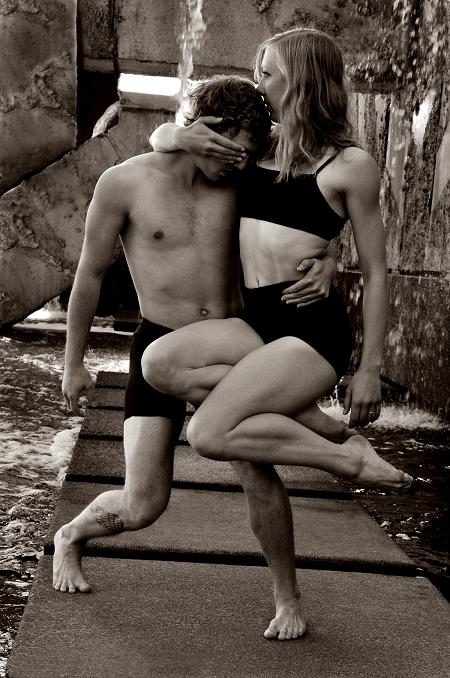Call me a bourgeois classicist, but I like pretty dance. Maybe a decade of ballet training left me partial to a streamline aesthetic and women in pointe shoes, but regardless, I think there is something undeniably appealing about watching dance rooted in beauty. Luckily, choreographer Robert Dekkers knows how to make dance that is both aesthetically pleasing and free from some of the more restrictive aspects of ballet. No tutus, tight buns, or overly sweet sugarplum fairies with Dekkers’ new contemporary ballet company, Post:Ballet. In its inaugural performance at Cowell Theater last weekend (July 16-17), the company proved that even classical ballet dancers are capable of moving with the free-flowing release associated with modern dance.
Post:Ballet’s “Concert One” opened with Dekkers’ Milieu (2009). The curtain rose to reveal the dancers—dressed in simple yet attractive Yumiko leotards and shorts—crouched, head in hands, in various folded shapes on stage. With live music and an exciting original score by SF based composer Daniel Berkman (known for his eclectic sound and mastery of the kora, a 21-string harp/lute from West Africa), Milieu instantly took on an innovative and experimental feel. Emerging from their crouching positions like primordial birds hatching from eggs, the dancers began dancing through a series of geometrical movements with both precision and fluidity. While the stage became a flurry of activity, the dancers—Alessandra Ball, Beau Campbell, Ashley Flaner, Jared Hunt, Beth Kaczmarek, David Ligon, and Christian Squires—maintained Dekkers’ complex, high-octane choreography with graceful vigor. Like Dekkers’ other pieces, Milieu does not revolve around a story-based narrative. Instead the highly expressive movements speak for themselves.
This is nowhere more evident than in Dekkers’ passionate duet B-Sides (2009). Christian Squires and Jared Hunt took the stage by storm as they moved together through interdependent, asymmetrical leans, expansive jumps and sleek gestures. Music by Grizzly Bear paired perfectly with the boys’ boundless energy and vibrant expression.
Just as impressive as the boys were the girls in Dekkers’ trio Flutter. Appearing onstage in flowy tops and black shorts, the three, long legged women—Campbell, Flaner, and Kaczmarek—looked like Grecian muses. The women moved through meticulous movements in rhythmic cannon to Steve Reich’s percussive Clapping Music before giving way to Bach’s Partita for Solo Violin No. 2 with more romantic, free flowing leg extensions and feather light rolls on the ground.
While the dancers all held their own throughout the show, it was in the closing piece—Dekkers’ newest work, The Happiness of Pursuit— that the dancers seemed the most comfortable and brought the most energy to the stage. As the dancers skipped, slid, and leaned up against each other to a score by Jacob Wolkenhauer, they embodied a playful and eager innocence. Even as the piece built in intensity and speed, the dancers — executing fast-paced leg kicks, intricate hand gestures, and urgent crawls — never lost their underlying joy. It is that sense of eager joy and fresh charisma that will see Dekkers’ Post:Ballet through many more concerts to come.

